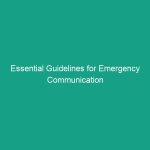Introduction
In today’s industrial world, health, safety, and Environment (HSE) concerns are paramount. The importance of workplace Safety cannot be overstated, especially when it comes to handling hazardous substances. Proper labeling of these substances is not just a regulatory requirement; it is a critical practice that protects workers, the environment, and the community. This article explores the essential guidelines for the labeling of hazardous substances, providing insights into regulatory frameworks, best practices, and future trends.
Understanding the Regulatory Framework
To ensure Workplace Safety, it is crucial to understand the regulatory frameworks governing the labeling of hazardous substances. These Regulations vary by country but generally aim to provide clear information about the risks associated with hazardous materials.
Global Standards and Agreements
One of the key global initiatives is the United Nations’ Globally Harmonized System of Classification and Labelling of Chemicals (GHS). This system standardizes the classification and labeling of chemicals, ensuring that hazard information is communicated effectively worldwide. The GHS introduces consistent criteria for classifying chemicals and provides a framework for labeling that includes:
- Hazard pictograms
- Signal words (e.g., “Danger” or “Warning”)
- Hazard statements
- Precautionary statements
National Regulations
In the United States, the Occupational Safety and Health Administration (OSHA) has adopted the GHS under the Hazard Communication Standard (HCS). Similarly, in the European Union, the Registration, Evaluation, Authorisation and Restriction of Chemicals (REACH) regulation plays a significant role in ensuring that hazardous substances are properly labeled. Understanding these regulations is essential for compliance and for the Safety of all personnel involved.
Best Practices for Labeling Hazardous Substances
Implementing Best Practices in the labeling of hazardous substances is vital for ensuring that all employees are aware of the risks they may encounter. Here are some key Best Practices to follow:
Clear and Concise Information
Labels must convey information clearly and concisely. Use simple language and avoid jargon. Ensure that all necessary information, such as Hazard Symbols and precautionary measures, is prominently displayed. The use of contrasting colors can enhance visibility and readability.
Regular Updates and Training
Labels should be updated regularly to reflect any new information about the Hazards or changes in regulations. Additionally, regular training sessions should be conducted to ensure that employees understand how to read and interpret labels correctly. This training should cover:
- Understanding hazard symbols
- Interpreting signal words
- Identifying precautionary measures
Use of Technology
Technology can play a significant role in improving the labeling of hazardous substances. Digital labeling systems can ensure that labels are easily updated and accessible. Moreover, using QR codes on labels can provide employees with instant access to Safety Data Sheets (SDS), which contain detailed information about the Hazards and Safety Measures associated with the substance.
Case Studies: Successful Implementation of Labeling Practices
To illustrate the importance of effective labeling, let’s examine a few case studies that highlight successful implementations of labeling practices in various industries.
Case Study 1: Chemical Manufacturing Industry
A chemical manufacturing company implemented a comprehensive labeling system that included color-coded labels for different categories of hazards. This system significantly reduced the number of accidents related to chemical exposure. Employees reported a better understanding of the risks, leading to safer handling practices.
Case Study 2: Construction Industry
In the construction industry, a well-known contractor adopted a digital labeling system that allowed for real-time updates to labels. This innovation not only improved compliance with safety regulations but also enhanced communication among workers on-site. The integration of QR codes linked to safety manuals resulted in a 30% decrease in incidents related to hazardous materials.
Challenges in Labeling Hazardous Substances
Despite the established guidelines and best practices, several challenges persist in the labeling of hazardous substances.
Compliance and Consistency
One of the main challenges organizations face is ensuring compliance with varying regulations across different regions. This inconsistency can lead to confusion among employees who may be trained in different systems or standards. Companies must invest in continuous training and updates to maintain compliance.
Employee Awareness and Engagement
Another significant hurdle is achieving employee awareness and engagement regarding labeling practices. Many workers may overlook labels due to habit or lack of understanding. Engaging employees through training programs and safety meetings can help raise awareness and improve adherence to safety protocols.
Future Trends in Hazardous Substance Labeling
The future of the labeling of hazardous substances is evolving with advancements in technology and a growing emphasis on Sustainability. Here are some trends to watch:
Smart Labels
Smart labels that incorporate RFID technology can provide real-time data on hazardous substances. These labels can offer dynamic updates regarding the status of the substance, including exposure limits and Safety Measures. This technology can enhance Workplace Safety and streamline compliance efforts.
Increased Focus on Sustainability
As organizations strive for more sustainable practices, there is a push towards labels that are environmentally friendly. Biodegradable materials and eco-friendly inks are becoming more prevalent in the industry, aligning with global sustainability goals.
Conclusion
The labeling of hazardous substances is a critical component of Workplace Safety that cannot be overlooked. By understanding the regulatory frameworks, implementing best practices, and staying informed of future trends, organizations can significantly reduce risks associated with hazardous materials. Regular training and engagement with employees will further enhance safety culture within the workplace. As we move forward, let us prioritize health, safety, and environmental considerations in all aspects of our operations. Together, we can create a safer working environment for everyone.


